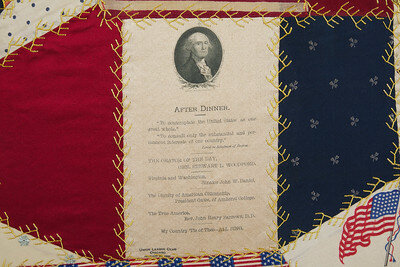Crazy quilts – a textile trend in the late 1800s – are often anything but crazy. These one-of-a-kind treasures are intentional statements, consisting of irregular shapes, intricate embroidery, and a myriad of fabrics. When a crazy quilt from 1890 was brought to The Center for treatment, our Textile Conservator was thrilled to work on such a unique piece.
The front of the piece before treatment.
The back of the piece before treatment.
According to American Patchwork and Quilting, Philadelphia's 1876 Centennial Exposition is considered an influence in crazy quilt design. "At the entrance to the most popular Japanese Pavilion, the image of a priest on a paved road introduced the concept of asymmetry to more than ten million people who attended. A cracked-ice, mosaic pattern on the path as well as other unfamiliar art forms—with images of storks, owls, fans, and flowers—were exotic attractions for Americans. They had become enchanted with anything Oriental and were replicating the look in their art, including quilts, dinnerware, furniture, and other decorations." The crazy quilt trend got so popular that fabric manufacturers would print whole cloth cotton imitating the erratic patchwork, and crazy quilt shows attracted hundreds of entries.
A map of 1876 Centennial Exposition.
Our client's crazy quilt was composed of silk and velvet. There was an enclosed note, which dates the piece to 1890 – meaning it was in great condition for its 131 years!
The enclosed note.
The quilt's face exhibited minimal fading, and while there were no losses or shredding, the brocade lining on the back exhibited an area of splitting along the fold lines.
Details from the quilt.
First, our conservators got to work by cleaning the surface with appropriate conservation materials. The quilt was then stitch mounted to a linen-covered stretcher, leaving a border around the edges. The handwritten inscription was safely mounted to the linen mount at the bottom center using Japanese tissue and conservation-grade adhesives.
The conserved note.
The piece was then installed in a custom UV Plexiglas vitrine, an acrylic glazing that protects against UV light rays. Finally, a coroplast backing board was attached to the reverse to provide additional protection.
The quilt after treatment.
The back of the vitrine.
We are honored to have helped preserve this crazy quilt so that its beautiful design – and fascinating history – can live on for years to come!
Sources:
https://www.lcpimages.org/centennial/
https://www.allpeoplequilt.com/quilt-patterns/history-of-the-crazy-quilt














